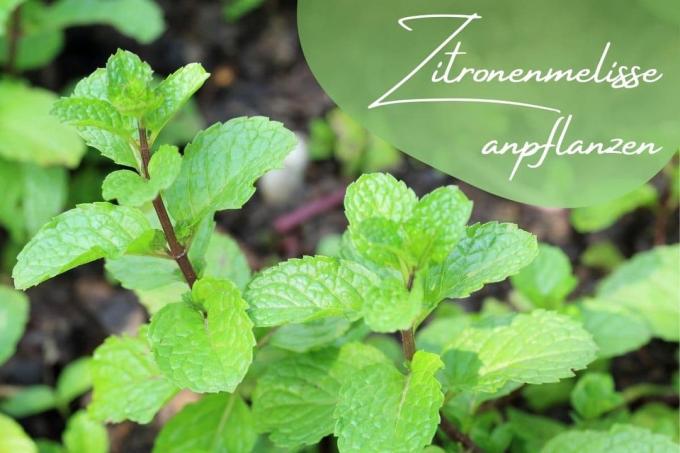
table of contents
- General
- Location
- floor
- Sowing and planting
- care
- harvest
- Multiplication
- sorts
- Pests
- Diseases
- Plant neighbors
- Winter protection
- frequently asked Questions
The herb with the lemony smell and taste is very popular. It is easy to maintain in the garden and enriches the kitchen. Here you can find out what to consider when planting lemon balm.
In a nutshell
- Synonyms: honey flower, heart comfort, bee herb, English lemon balm
- is suitable for drinks and food
- Medicinal properties: calming, anti-inflammatory, antispasmodic
- Can be cultivated outdoors or in pots
General
The lemon balm (Melissa officinalis) was native to the Mediterranean area, but it also grew wild here. It is accordingly winter hardy and can cope with adverse conditions. The rhizome forms numerous runners, and the seeds are also very prolific. In the garden, the plant is one of the growing herbs. It reaches a height of almost one meter.

Location
The cheapest is a sunny place. Partial shade is also tolerated, full shade makes the plant grow poorly. The place should be airy but not windy. You can also plant lemon balm as a container plant, the sunny terrace is a good location here.
floor
The lemon balm does not need a lot of nutrients, it is one of the weak eaters. A well-drained soil that is neither too wet nor too dry is an advantage. Normal herb soil or garden soil mixed with sand is suitable in the bucket.
Sowing and planting
Growing from seeds
Sow in March or April, preferably in a warm place. If no cold frame or Glasshouse is available, a bright window in a warm room is sufficient. The seeds are only covered with a little soil and germinate after three to four weeks. After a further six weeks, the young plants can be planted outdoors.

Plant young plants
It does not matter whether the plants are bought or grown yourself. They are planted out with a planting distance of 30 x 30 cm. If there are other plants on the bed, the distance to them should also be correspondingly large.
Note: Water young plants well after planting.
care
In general, this herb does not require much attention. It is sufficient if the young plants are initially kept moderately moist. A little fertilizer in the form of compost or mulch in the spring won't do any harm.
Note: In the case of potted plants, a little more effort is required for watering and fertilizing, as the substrate leaches out or dries out faster due to the limited volume.
harvest
As soon as the lemon balm begins to form fresh shoots, you can harvest them. Don't cut off too many leaves at first. A full harvest is possible before flowering, in May or June. Then the entire plant is cut off about 10 cm above the ground. A second harvest can take place in September under favorable conditions.

Multiplication
If it has a good location and enough space available, the lemon balm will spread on its own. However, this can also be a disadvantage, which is why a root barrier is useful if there is limited space. Or the herb moves into a pot. If propagation is desired, an older plant can easily be divided and propagated over parts of the rootstock.
sorts
- 'All Gold', yellow foliage, thrives better in partial shade or without the midday sun
- 'Binsuga', particularly aromatic
- 'Citronelle', high content of essential oils
- 'Variegata', yellow variegated foliage, particularly attractive
Pests
Since lemon balm is very robust, there are hardly any pests or diseases. Aphids rarely become a nuisance; there are usually enough beneficial insects to consume them. The same applies to an infestation with green tortoise beetles.
Diseases
Lemon balm also rarely has diseases. Among other things, this can be leaf spot disease or powdery mildew. However, the entire plant is never in danger, as long as it is strong and otherwise healthy. If the stains disturb you, they can simply be cut out.
Plant neighbors
Other perennial herbs such as tarragon, sage, chives and thyme are good neighbors for lemon balm. In any case, care must be taken that the lemon balm does not overgrow the other herbs. Annual herbs such as dill or basil are less suitable.

Winter protection
The lemon balm is hardy and generally does not need any protection. Something different applies to potted plants. These should be kept cool and bright in the house over the winter. A good place is a greenhouse. The harvest can also be brought forward there.
frequently asked Questions
The fresh / fruity aroma goes particularly well with crunchy salads. Lemon balm is also suitable as a decoration on desserts or in cold drinks.
On the one hand, the leaves can be dried. The second option is freezing. The latter receives more aroma and ingredients and is preferable to drying.
This herb can stay in the same place for a very long time, provided that it is cared for there accordingly. Something else applies to pot culture, in which case the lemon balm has to be repotted regularly.
Yes, it's not for nothing that this lemon balm is also called bee weed. When it blooms it is an excellent pasture for bees. If you want to constantly harvest fresh leaves, you can cut back a few shoots before they bloom. Even if you don't like lemon balm as a culinary herb, planting it as an insect food is worthwhile.
